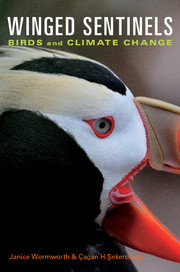Book contents
- Frontmatter
- CONTENTS
- ACKNOWLEDGEMENTS
- Introduction: The Free Advice of Birds
- Chapter 1 Phenology: Seasonal Timing and Mismatch
- Chapter 2 Migratory Birds Face Climate Turbulence
- Chapter 3 Range Shifts and Reshuffled Communities
- Chapter 4 Seabirds Herald Ocean Changes
- Chapter 5 Climate Change, Abundance and Extinction
- Chapter 6 Tropical Warming and Habitat Islands
- Chapter 7 Shifting Ground on Conservation
- NOTES
- INDEX
- PLATE SECTION
- PLATE SECTION
- PLATE SECTION
Chapter 3 - Range Shifts and Reshuffled Communities
Published online by Cambridge University Press: 05 March 2012
- Frontmatter
- CONTENTS
- ACKNOWLEDGEMENTS
- Introduction: The Free Advice of Birds
- Chapter 1 Phenology: Seasonal Timing and Mismatch
- Chapter 2 Migratory Birds Face Climate Turbulence
- Chapter 3 Range Shifts and Reshuffled Communities
- Chapter 4 Seabirds Herald Ocean Changes
- Chapter 5 Climate Change, Abundance and Extinction
- Chapter 6 Tropical Warming and Habitat Islands
- Chapter 7 Shifting Ground on Conservation
- NOTES
- INDEX
- PLATE SECTION
- PLATE SECTION
- PLATE SECTION
Summary
Climate‘s role in bird distributions
Dwindling ecological capital at the world's biggest duck factory
In North America, changes to the climate of the world's most productive waterfowl habitat could put this ‘duck factory’ on a path towards an even greater conflict with human development. Both the origins and the future fate of the Prairie Pothole Region are inextricably linked to changes in climate. When ice sheets moved across North America more than ten thousand years ago, they scoured depressions and left uneven deposits of sediment. This glacial sculpting laid the groundwork for a roughly 700 000 square kilometre swathe of millions of wetland ponds, dotted across the grasslands of the Northern Great Plains. Frigid winters lock the region in ice and snow but in spring, melting snow and rain fill the ponds. The rapidly greening landscape comes alive and its ponds harbour a veritable explosion of aquatic life. Beyond the bulrushes of pond margins, concealed in long grasses on nearby land, millions of nests produce the majority of the continent's ducks in most years. The region also provides crucial breeding and stopover habitat for migratory birds.
The Prairie Pothole Region's suitability for farming, however, has led at least half of its ponds to be drained or altered – a classic case of human land use in conflict with internationally important wildlife habitat. On top of this habitat-loss threat, climate trends over the last century have made this region's eastern wetlands too wet and its western ones too dry. In both cases this has reduced wetland productivity.
- Type
- Chapter
- Information
- Winged SentinelsBirds and Climate Change, pp. 63 - 94Publisher: Cambridge University PressPrint publication year: 2011



